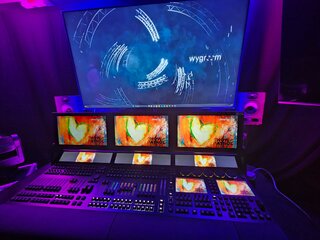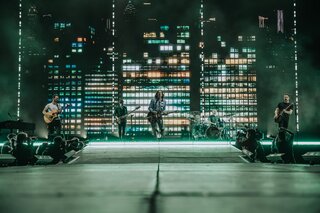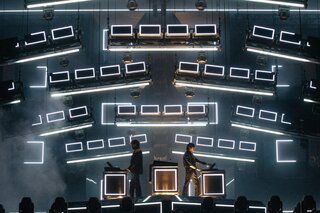I peeked behind the scenes at a music festival. "These were the artists' craziest requests."

July 18, 2025, the third day of this year's Colors of Ostrava – a music festival that has been held since 2012 at a large post-industrial complex in Dolní Vítkovice. Just before 3 p.m., the 2022 Eurovision Song Contest winners, the Ukrainian band Kalush Orchestra, are preparing to perform on the main stage, the Česká spořitelna Stage. We have the opportunity to take a look behind the scenes at one of the largest music events in the Czech Republic. This year, Polish artists Rat Kru, How We Met, and Zamilska also performed.
We start with the LD Room (light design room) – the stage lighting command center that creates the drama of performances on the main stage.
A member of the Snow Patrol crew was working here just before we entered. The screen also displays a graphic element – a heart, which the audience saw during their concert that evening. Later, our guide showed us a 3D view of the stage and the lighting mounted above it. The software reflects the actual layout of all the lights on stage.

"It works like this: the artist's lighting technician brings his programmed performance here, uploads it, and, using the preview, adjusts the lights to the performance plan. This takes one to three hours, usually two. He can do the same thing using the same console on stage, but the conditions there are worse—for example, he might be in a hurry or the sun might be in the way. He then uploads this set of settings to a flash drive and connects it to the live stage," he says.
The stage setup for Justice, who performed on the second day of the festival, was a bit different. Lighting plays a huge role during this duo's concerts. In Ostrava, the French band used around 30 spotlights on the main stage, bringing the rest themselves – including a movable lighting element that lowered over the artists during selected moments.


This is just a preparation phase. No one will be in this room during the concert.
Behind the scenes at Colors of Ostrava. No photos allowed here.We move to an area where, in accordance with the organizers' policy, no recording or photography is allowed to ensure the artists' privacy. Kate Hummel, the international Booker (the person responsible for inviting artists) and the director of the Meltingpot discussion forum, which accompanies the festival, invites us in. The dressing rooms are located in a white tent. Do the artists spend much time there before the concert?
Some arrive on Wednesday and stay until the last day. Others arrive just before a show and leave shortly after, because they have another one planned for the next day. "Sting spent all afternoon here on Wednesday, and we passed each other a few times. Iggy Pop also enjoys spending time at our festival ," Kate tells us.
Riders. What do artists wish for?One of the most tempting targets for gossip media is riders – the list of artists' requirements for the tour. This includes not only the technical support that the organizer should provide, but also the performers' wishes, which they should fulfill – regarding menus and dressing room arrangements.
Although we often think, "They're out of touch with reality," Kate treats all these wishes with respect. "Imagine a situation where, during a long tour, you eat the same thing for dinner almost every day," she notes. This set of wishes helps avoid monotony.
The festival's facilities can also change depending on the people accompanying the musicians. "In recent years, we've built a small swimming pool and a playground here. It's very interesting to see how the artists go about their daily lives, with their spouses and children by their side," he says.
Some musicians have special requests, like a gaming console. We asked Kate about the strangest requests she's ever received. She shares them without revealing the artists' names.
"Last year, one of the headliners missed his dog, so he sent us a picture of it and asked us to find a similar one he could pet and take for walks. Another artist last year was looking for someone to continue playing for him so he wouldn't lose his progress. So we found a guy to play for him," says Kate. There was also a very traditional request – to provide the current print edition of the New York Times. There's hope for print media yet!
Against this backdrop, Sam Smith's wish for a proper barbecue doesn't seem so crazy. Food and drink requests can be sophisticated, but sometimes they're surprisingly simple.
"I love people like Robert Plant, who ask for local products—they say, 'I want to try your beer and your local food,'" recalls the organizer. And the disappointment from the organizers? Sometimes, you put a lot of effort into importing a specific product, and it doesn't even get tried.
The tent behind the main stage also houses a photography studio set up specifically for the festival, and at the end of the hall, a kitchen operates 24/7. This area also has to adapt to the frenetic pace of life on the road. There are no set meal times. Anyone wanting lunch at 1 a.m.? It's no surprise.
There is also a relaxation area with couches, table football and fridges from which you can choose any drinks.
"It may seem strange that artists sometimes refuse interviews, but I try to understand. In their free time before a performance, they just want to be themselves, read the newspaper, or gather energy for a performance. Popularity is their dream, but it can also be a burden," says the organizer.
It's clear that she enjoys working at the festival.
"It's exciting trying to figure out what artists want. Sometimes it's like a game of telephone, reading wish lists and asking others, 'Do you know what this might be?'" he says.
Finally, we peek into a separate kitchen, designated for festival staff, employees, and volunteers. After all, an event of this scale involves more than just big-name artists—it also involves thousands of people working in the background to ensure the concert madness remains safe. Organizers announced that this year's festival was managed by a team of nearly five thousand people, including technicians, paramedics, firefighters, security services, and other professionals.
Meanwhile, we emerge from the wings towards the main stage, where the Kalush Orchestra is already performing. Although our visit was organized so as not to disrupt the performers' schedules, and we didn't even manage to pass them, we did briefly get closer to their world – a small, peaceful haven on their journeys across countries and continents. After the concert in Ostrava, Sting headed to Finland, and Iggy Pop in the opposite direction – just two days later, he was entertaining audiences in Spain at the Santo Domingo de la Calzada festival.
Read also: A festival and a famous tourist attraction in one. You can see it from nearly 80 meters. Read also: Ewa Farna on life in the Czech Republic: We have a cool president, a safe time.
Wprost




